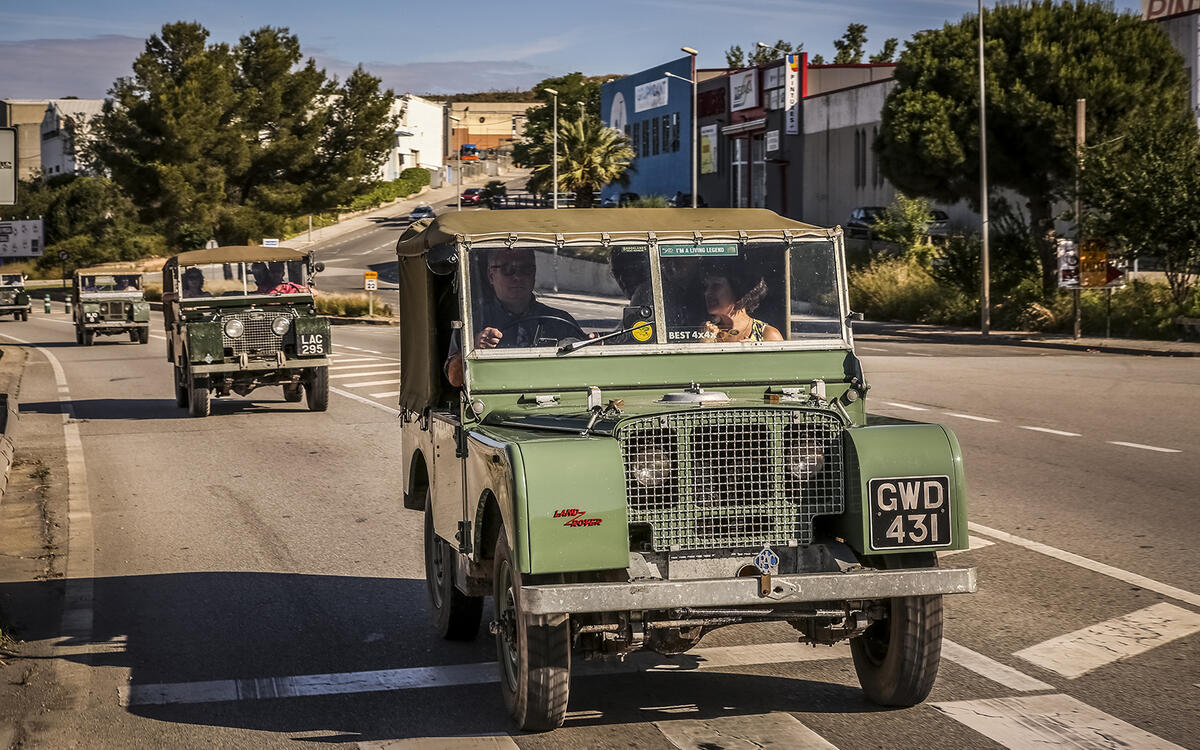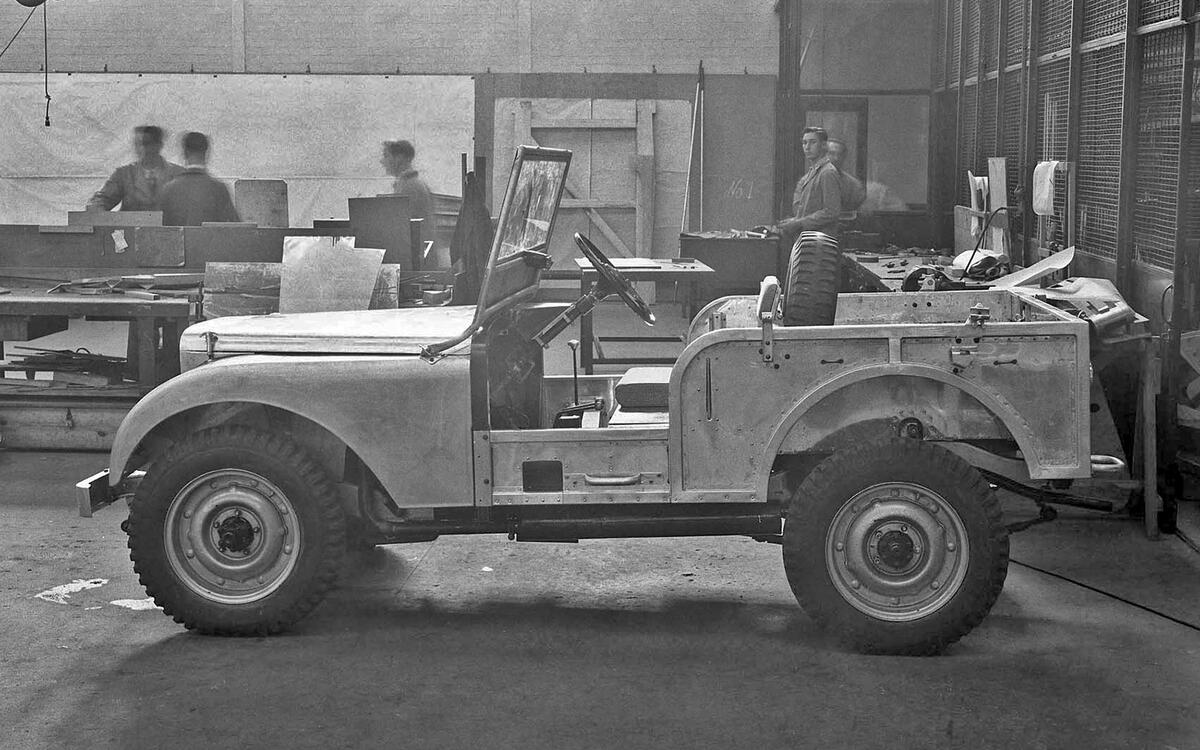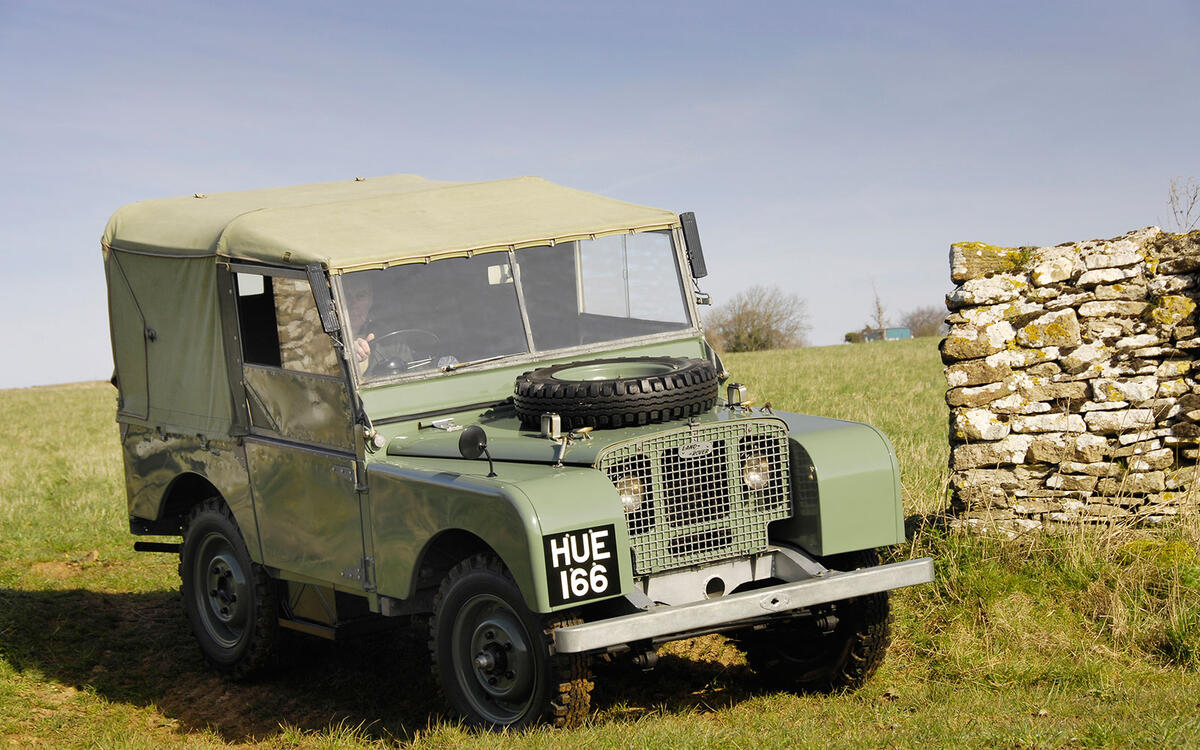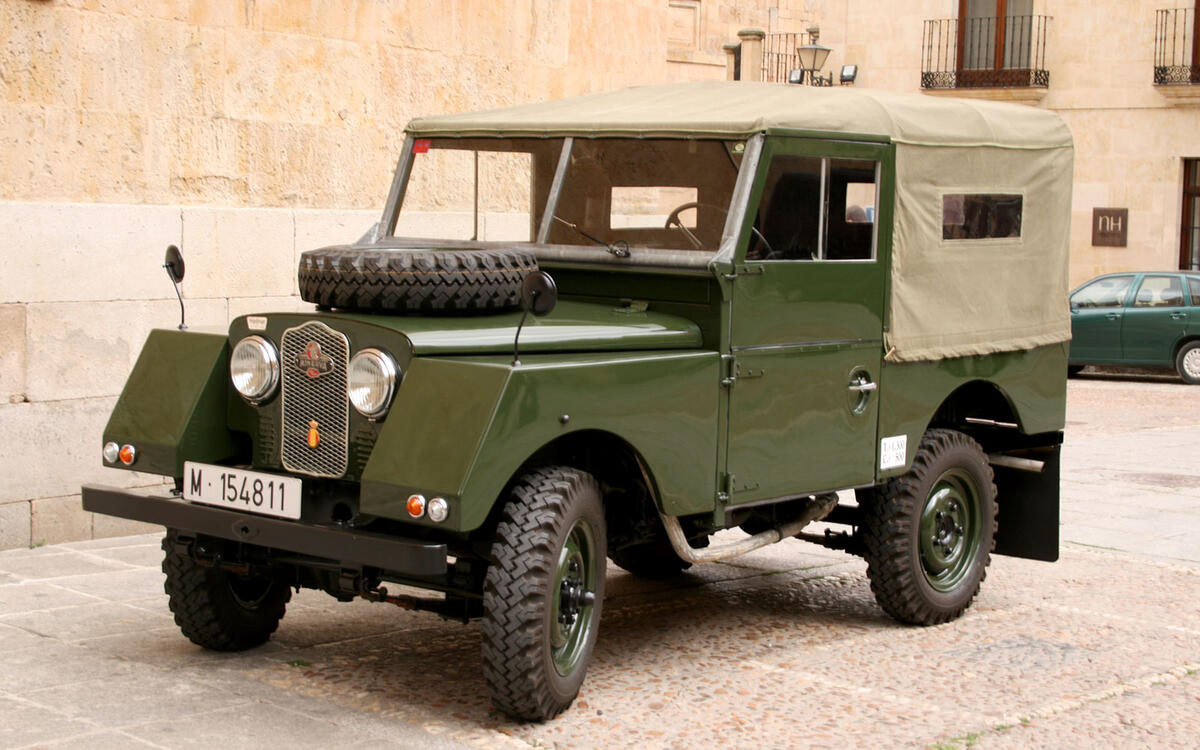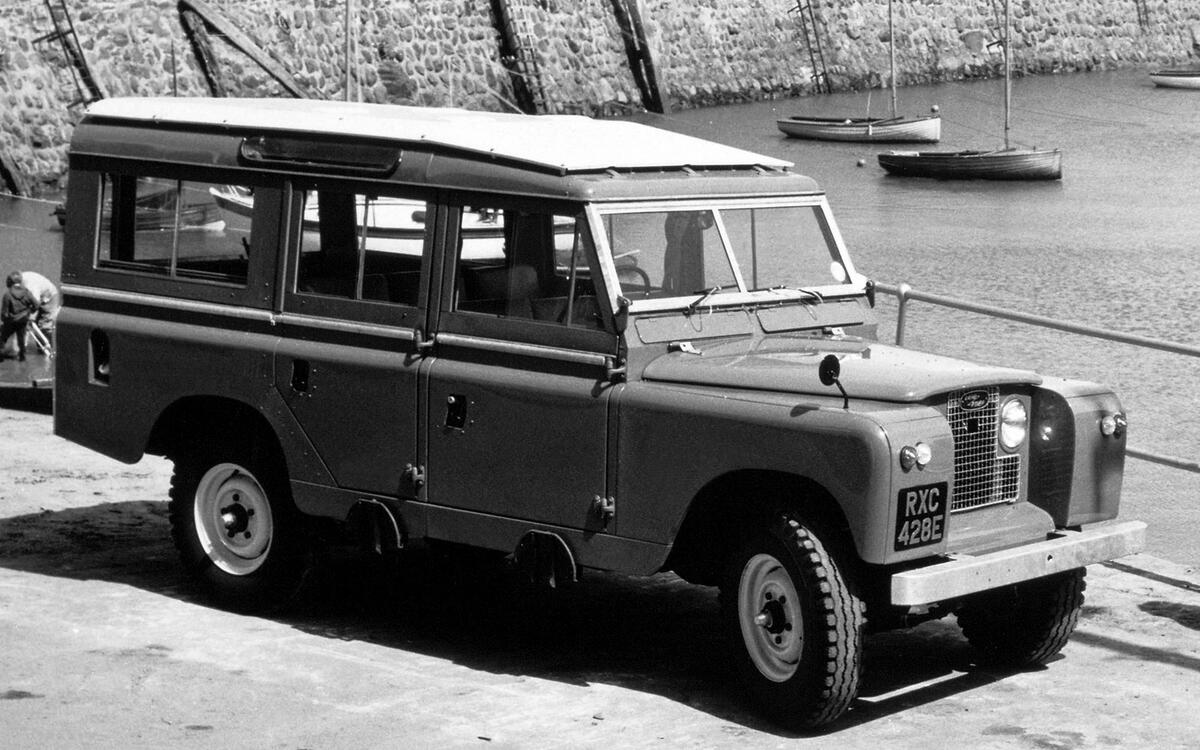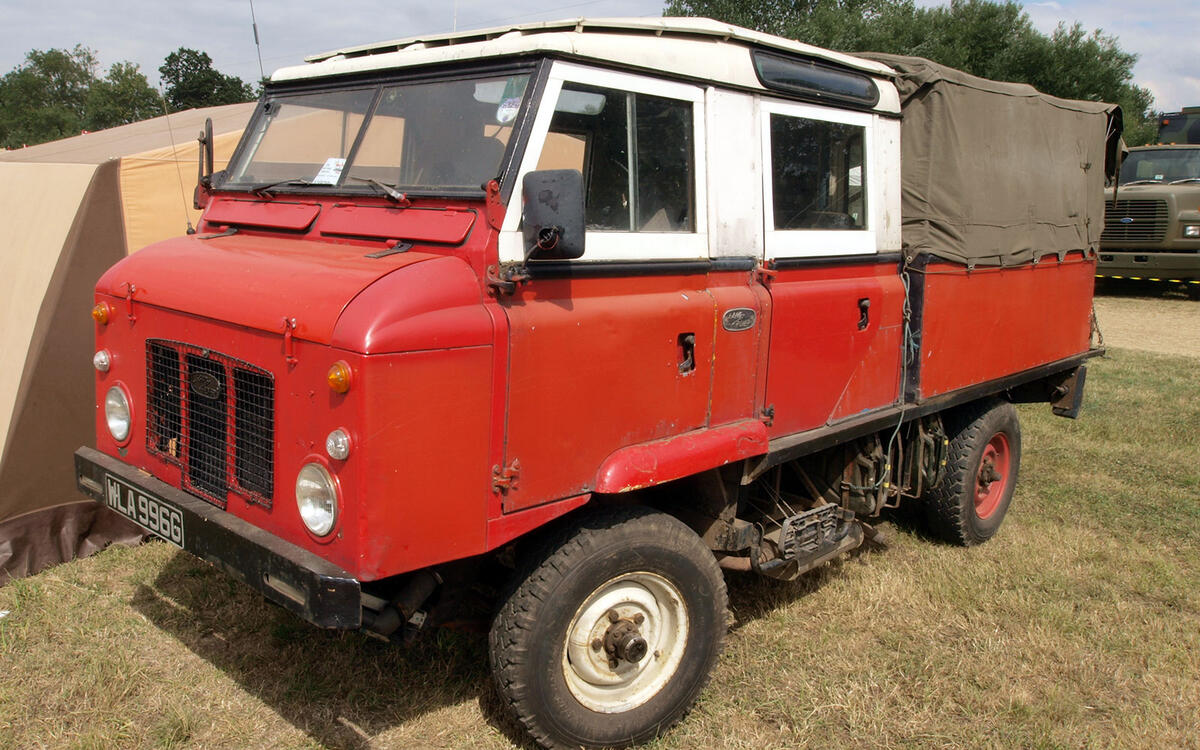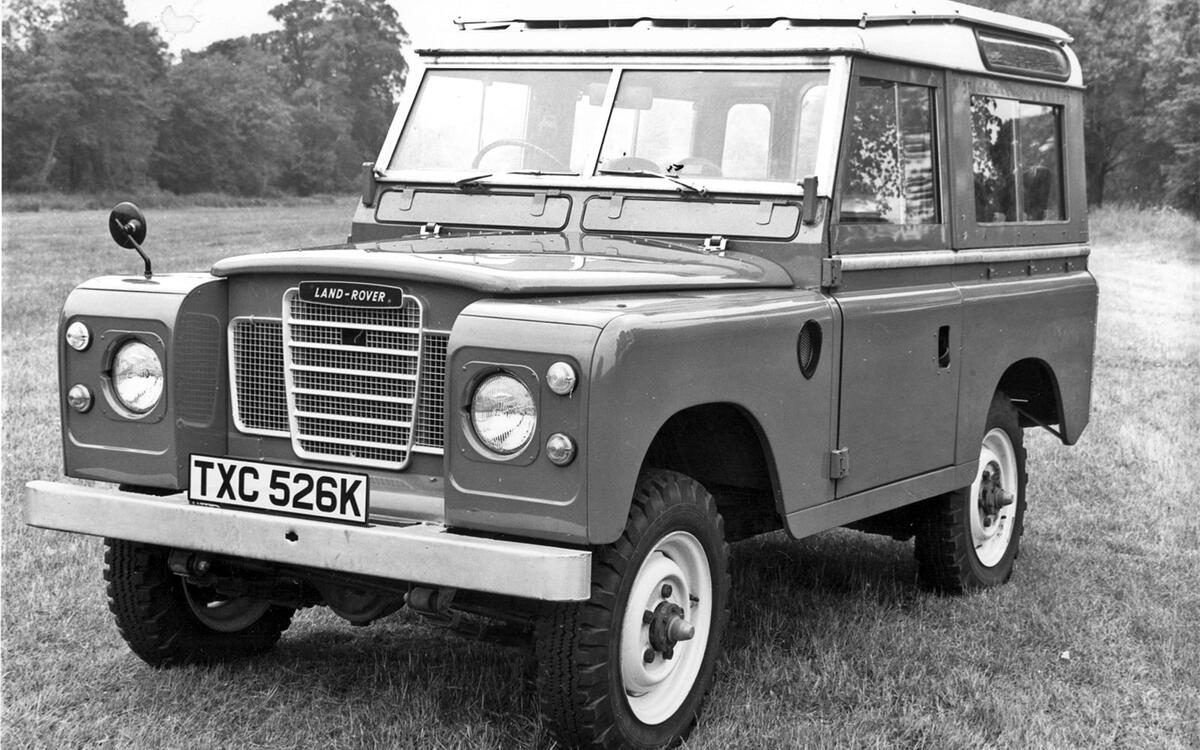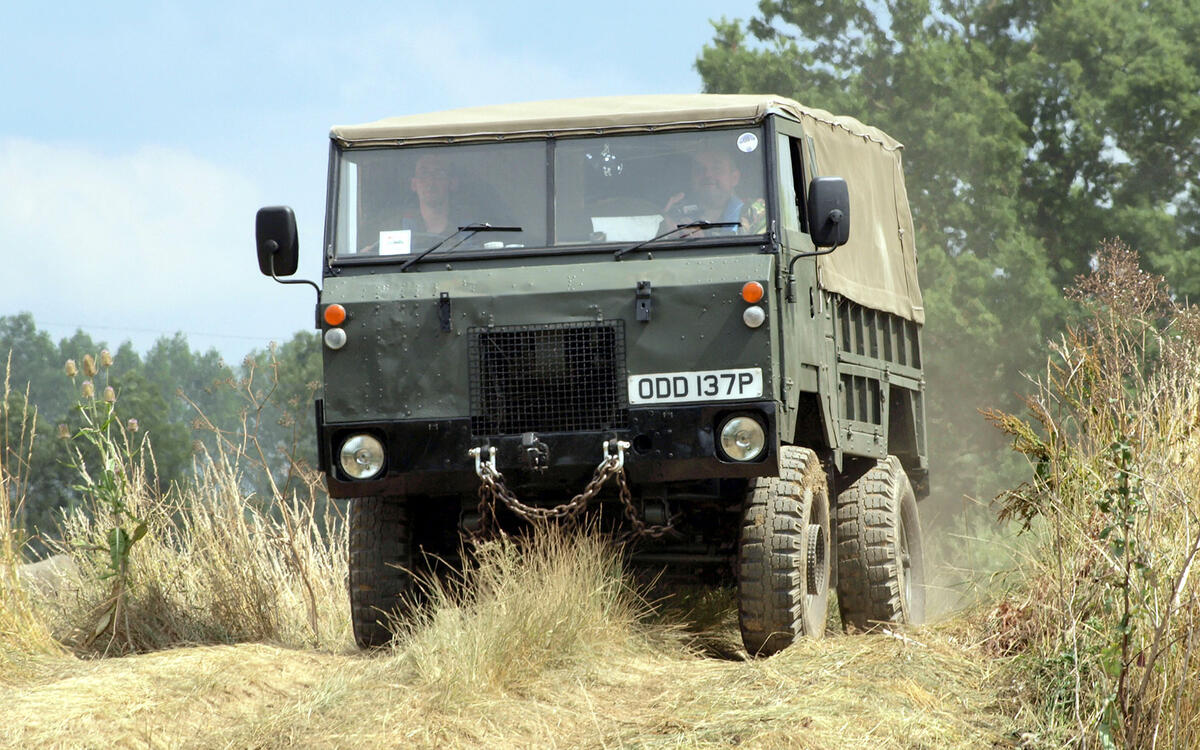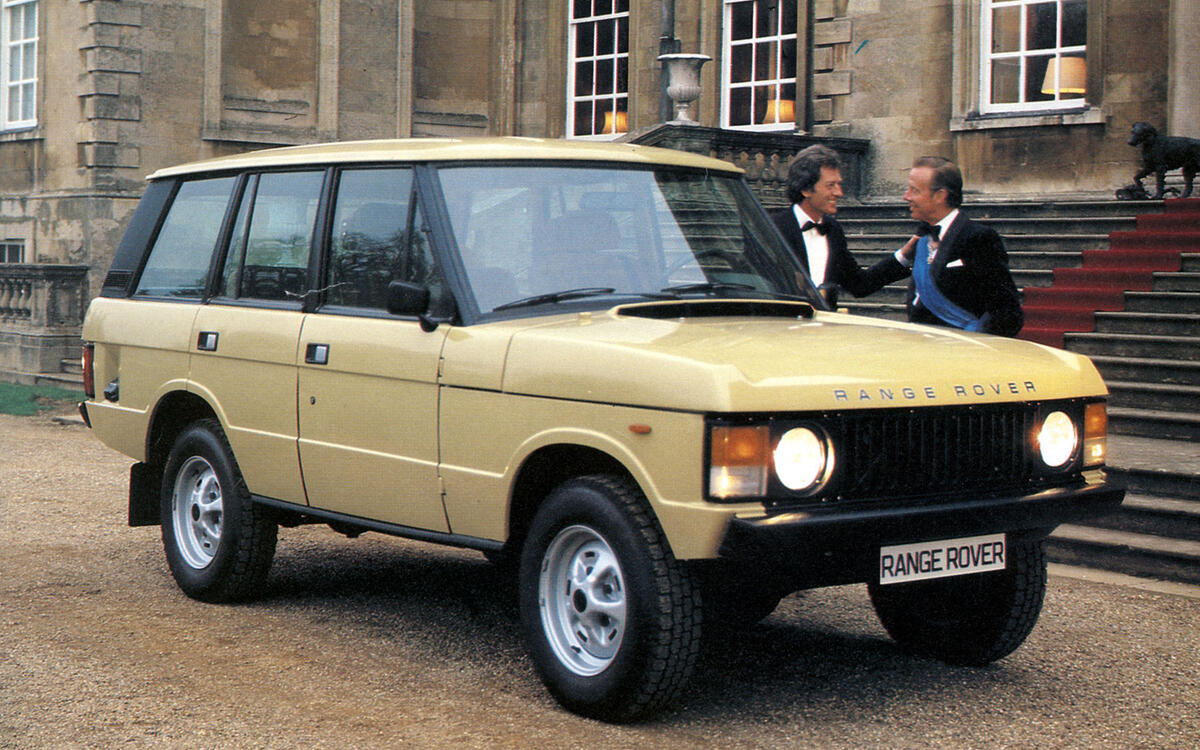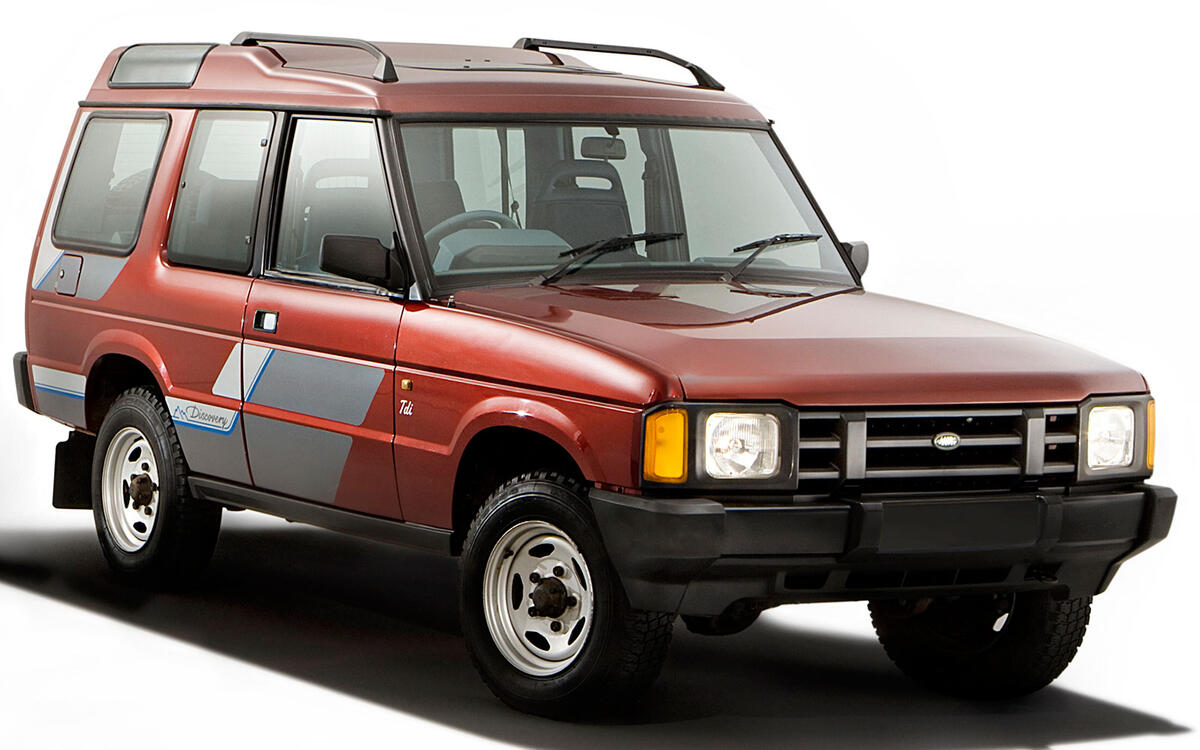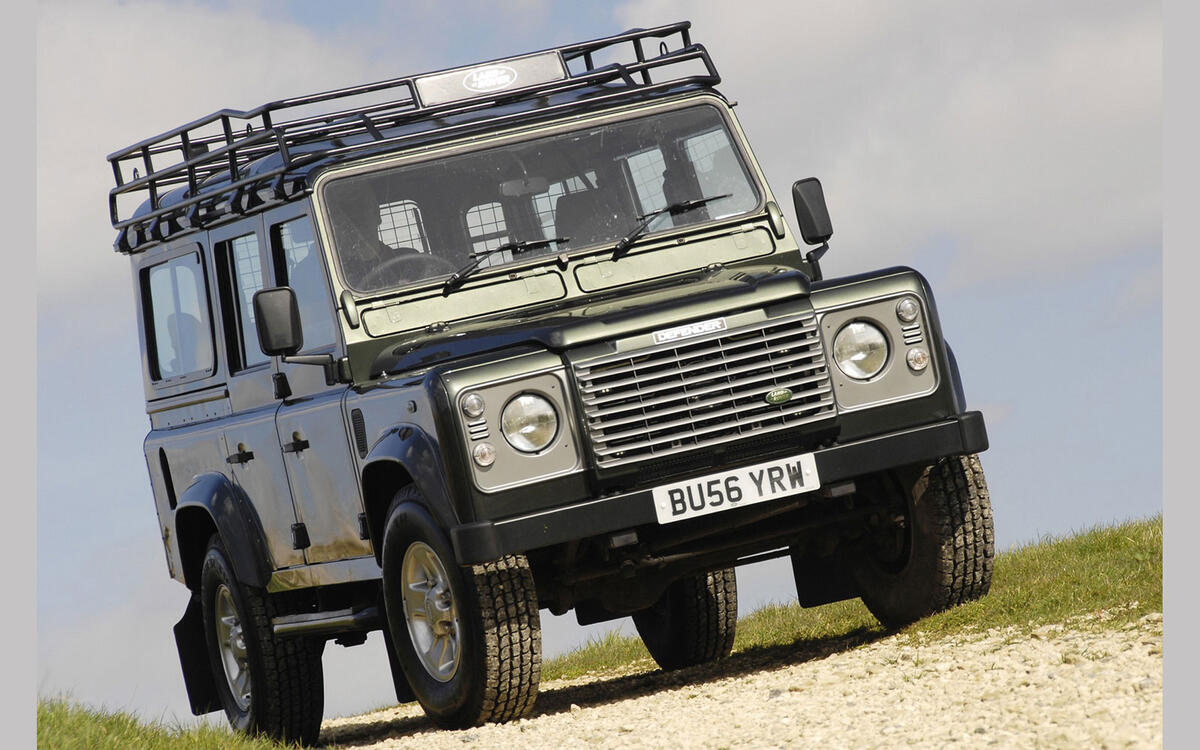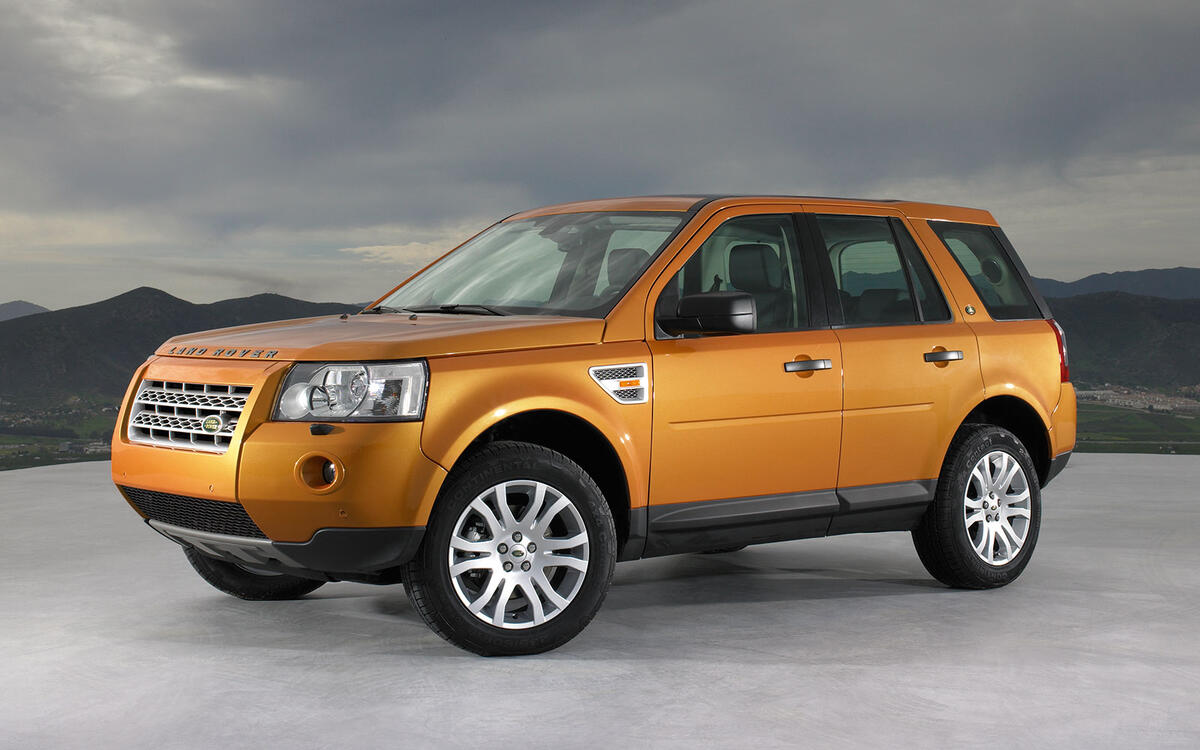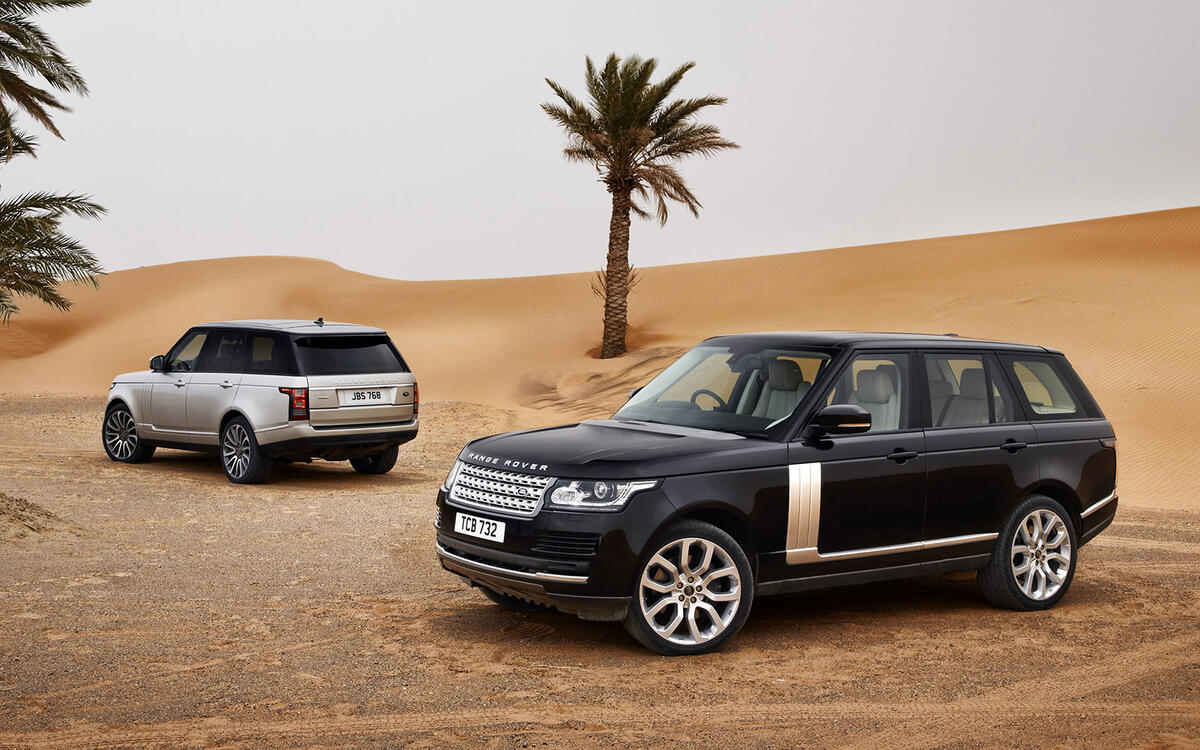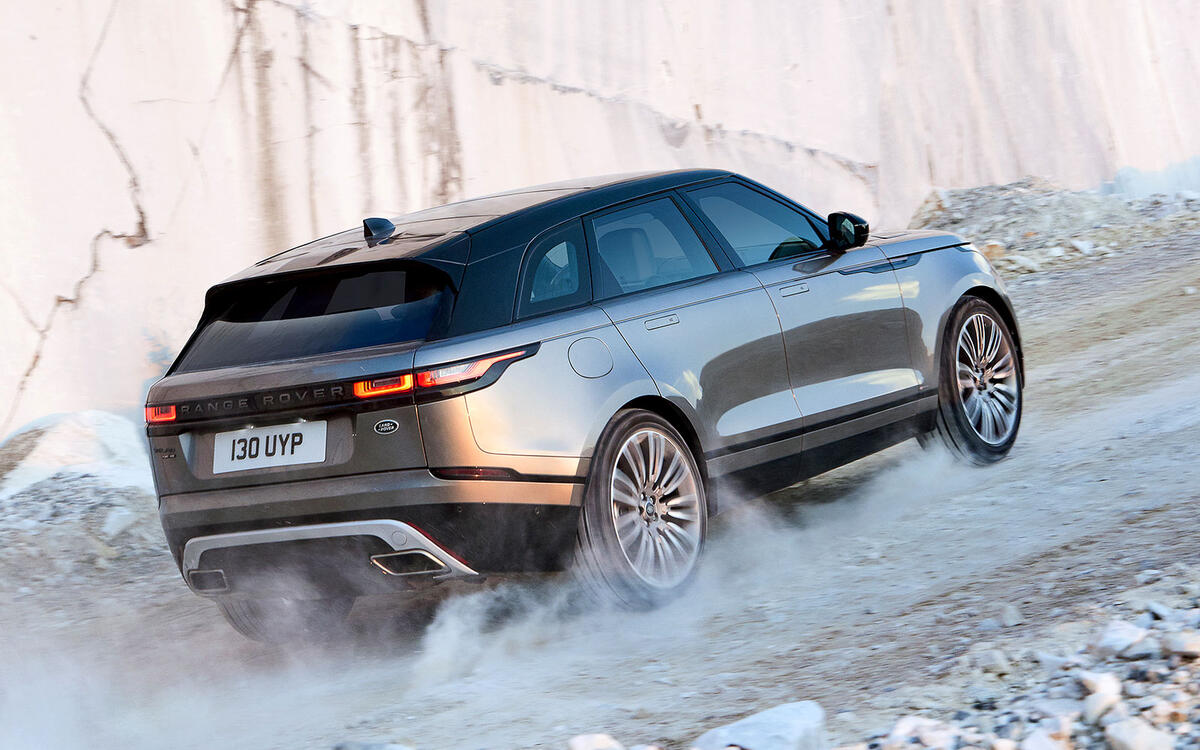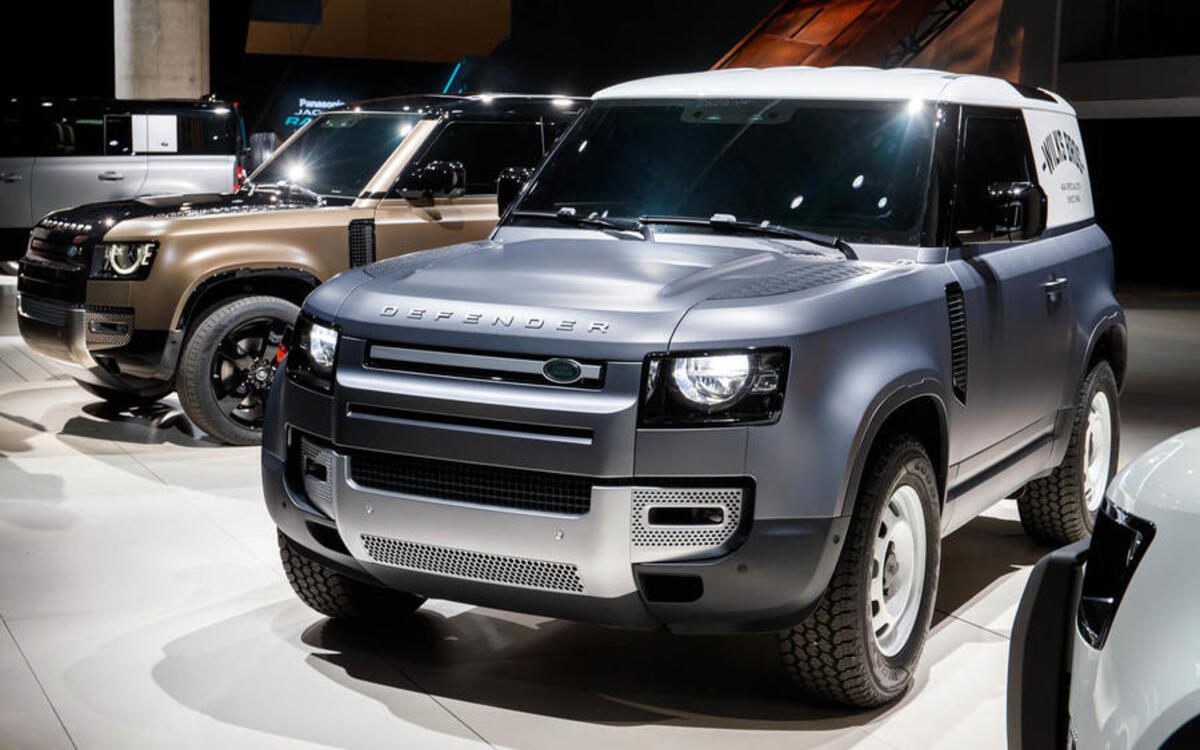 Slide of
Slide of
Land Rover History
Land Rover’s history spans more than seven decades, a surprisingly high number of cars and a whole bunch of ingenuity.
Britain’s answer to the Jeep was revealed to the world at the Amsterdam motor show on 30 April 1948 as a tough, basic, go anywhere kind of vehicle.
This ethos was stuck to until the arrival of the Range Rover in 1970, marking the beginning of a move upmarket.
Keep reading to discover how Land Rover went from making some of the most rugged vehicles, to some of the most opulent.
 Slide of
Slide of
Land Rover prototype (1947)
If you thought the production cars were basic, they were positively lavish compared with the prototypes. This one, in the Lode Lane jig shop in 1947, featured its steering wheel in the centre, McLaren F1-style. The Landie wasn’t as quick as the McLaren but it was better at ploughing fields.
 Slide of
Slide of
Land Rover Series I (1948)
The first ever production Land Rover, launched in 1.6-litre form with an 80-inch wheelbase; pictured is the first pre-production prototype. Later we’d get long-wheelbase editions (107/109-inch wheelbase) to go with the short-wheelbase (86/87-inch) model, a 2.0-litre petrol engine (from 1951) and a 2.0-litre diesel (from 1957). By the end of the year Land Rover was exporting to 70 countries; the US followed in 1949.
 Slide of
Slide of
The Series I is extended (1953)
The 80-inch wheelbase of the original Series I meant a minimal carrying capacity, so in 1953 the Series I was stretched by six inches. A long-wheelbase pick-up and Station Wagon were also introduced. Three years later the wheelbase would grow by another two inches.
 Slide of
Slide of
Land Rover Minerva (1954)
Belgian company Minerva was founded in 1900 to make bicycles, but within two years production had expanded to include cars as well. By the outbreak of World War 2 Minerva had seemingly run out of steam, but in 1954 a deal with Land Rover was signed for the Series I to be built under licence, although production lasted only until 1956.
 Slide of
Slide of
Land Rover diesel conversion (1955)
Even the crude diesel engines of the 1950s were ideal for off-roading thanks to the increased range and extra low-down torque. But Land Rover wouldn’t offer a diesel version of its Series I until almost the end of its production run – which is why specialists such as Turner Engineering offered an independent solution.
 Slide of
Slide of
Far Eastern Expedition (1955)
Throughout the 1950s and 1960s dozens of expeditions were undertaken using Land Rovers. One of the first and biggest was the Far Eastern Expedition, undertaken by six Oxford & Cambridge graduates. They set themselves the task of embarking on the longest possible overland journey: London to Singapore, from the Atlantic to the Pacific. They covered 12,000 miles in six months – then turned round and drove back.
 Slide of
Slide of
Land Rover Series II (1958)
After a decade of production the Series II took over from the Series I, with a new 2.25-litre petrol engine. The restyled bodyshell now featured a curved shoulder line which would stay until the last car was built almost 60 years later.
 Slide of
Slide of
Land Rover Santana (1958)
It suited Land Rover to licence its products for overseas production, which is why in 1958 a deal was struck with Spanish company Santana to assemble Completely Knocked Down (CKD) kits. The partnership lasted rather longer than the one with Minerva – right the way up to 1983.
 Slide of
Slide of
Business booms (1959)
This transporter shows five early Series IIs on their way to new owners. This picture was taken in 1959 – the same year that the 250,000th Land Rover was built. The 500,000th was built in 1966, the 750,000th in 1971 and the millionth in 1976.
 Slide of
Slide of
Land Rover Series IIa (1961)
The Series IIa ushered in a 2.25-litre diesel engine, then in 1969 the in-board headlamps were relocated to the front wings. From 1967 a 2.6-litre straight-six petrol engine was available in long-wheelbase models (pictured here).
 Slide of
Slide of
Forward Control (1962)
Based on the Series IIa, the Forward Control was a lorry that was launched in response to requests for a vehicle with an increased payload. While it could carry a lot more than a regular Series IIa, the 2625cc straight-six petrol engine struggled to pull it along with all of 90bhp and 132lb ft of torque.
 Slide of
Slide of
Land Rover Lightweight (1968)
Developed specifically for the military, the Lightweight came in Series IIa (pictured here) and Series III forms. Available only to the armed forces and ex-servicemen, the Lightweight was designed to be suspended from helicopters and dropped from aircraft. Don’t let the name fool you though; these cars were heavier than the regular Land Rovers that sired them.
 Slide of
Slide of
Land Rover Velar (1968)
In the US, luxury SUVs were big business and if Land Rover wanted to expand, it had to grab a slice of the top end of the market. The company started to develop its own luxury SUV, powered by the Buick-derived V8 that Rover had bought the rights to manufacture just three years earlier. Each prototype was badged VELAR, to throw media off the scent.
 Slide of
Slide of
Range Rover Classic (1970)
It’s often credited with launching the luxury SUV boom, but the original Range Rover wasn’t really all that posh inside. Besides, the 1963 Jeep Wagoneer got there first. What the Range Rover did do was set Land Rover on a never-ending upward trajectory in terms of levels of luxury and sophistication.
 Slide of
Slide of
Land Rover Series III (1971)
There’s not much to distance this from the Series II aside from an all-synchromesh gearbox, revised instruments and stronger brakes. Purists hated the new plastic radiator grille but Land Rover didn’t care; it was on a roll with the production lines running flat out to satisfy demand.
 Slide of
Slide of
Land Rover 1 Tonne Forward Control (1972)
Land Rover revisited the elevated lorry formula, but this time there was a 3.5-litre petrol V8 that provided 128bhp and 185lb ft of torque. When launched there was a powered trailer available for maximum traction, but it led to the vehicles rolling over so it was given the chop.
 Slide of
Slide of
Land Rover Series III V8 (1979)
Serious off-roading needs a decent engine with plenty of power and torque; the Buick-derived 3.5-litre Rover V8 already seen in the Range Rover was just the thing to turn the Series III from a plodder into a car with genuinely decent performance, even if the fuel bills were alarming.
 Slide of
Slide of
Range Rover four-door (1981)
Swiss supercar builder Monteverdi started converting two-door Range Rovers into four-door models in 1980 and Land Rover noticed its success. So LR developed its own version, which went on sale the following year. In 1982 the 100,000th Range Rover was delivered – the same year that an automatic gearbox first became an option.
 Slide of
Slide of
Land Rover 90 and 110 (1983)
The Land Rover County arrived in 1983, in 110-inch form with the Range Rover’s coil-spring suspension, a five-speed gearbox, front disc brakes, a one-piece windscreen and optional power steering. A year later the short-wheelbase 90 arrived, with three doors instead of five.
 Slide of
Slide of
Land Rover Discovery (1989)
There was a yawning chasm between the Land Rover and the Range Rover – one that the Japanese had exploited with models like the Mitsubishi Shogun and Toyota Land Cruiser. Land Rover wanted a piece of that action so it launched the relatively utilitarian Discovery, initially in three-door form and based on the Range Rover’s underpinnings. At first there were petrol V8 or turbodiesel engines to choose from; later came a two-litre four-pot.
 Slide of
Slide of
Land Rover Defender (1990)
To some, all classic Land Rovers are called Defender, but it wasn’t until 42 years after the arrival of the Series I that this tag was adopted to differentiate it from the new Discovery. The renamed model got a new 200 TDi turbodiesel engine, as already seen in the Discovery.
 Slide of
Slide of
Range Rover LWB (1992)
The Range Rover was taken even further upmarket in 1992 with the introduction of a long-wheelbase model. The car incorporated several firsts for the off-roader segment including air suspension and electronic traction control.
 Slide of
Slide of
Range Rover P38 (1994)
Too sophisticated for its own good, the follow up to the Range Rover Classic was even more luxurious and looked the part, but it was under-developed when launched and suffered never-ending reliability problems. As a result most have now bitten the dust, but one day they’ll be very collectible – simply because so few will be left.
 Slide of
Slide of
Land Rover Freelander (1997)
To increase sales volumes Land Rover had to make its products more accessible – which meant making them smaller and in greater numbers. The Freelander was the answer, funded by BMW, which bought Rover, including Land Rover, in 1994. A compact off-roader that could tackle tricky terrain more easily thanks to its revolutionary Hill Descent Control system. Available with three doors or five and with petrol or diesel power, the Freelander soon became Land Rover’s fastest-selling model.
 Slide of
Slide of
Land Rover Discovery 2 (1998)
It didn’t look much different from the original but the second take on the Discovery was a far better car with its better build quality and a longer bodyshell that now featured three rows of forward-facing seats (the Disco 1 featured side-facing flip-down seats in the boot); all Discoverys now came with five doors.
A new turbodiesel engine was also available (the TD5) and another innovation was Active Cornering Enhancement (ACE), a computer-controlled high-pressure hydraulic system to control vehicle roll.
 Slide of
Slide of
Range Rover L322 (2002)
The third take on the Range Rover formula took the brand to new heights in terms of both luxury and off-road abilities. Largely paid for by BMW, Ford reaped the benefit after it bought Land Rover in 2000. It was still no paragon of reliability, but if you wanted an alternative to a luxury saloon the new monocoque-construction Range Rover was easily good enough to compete. Buyers could choose between 3.0-litre straight-six diesel or 4.4-litre V8 petrol units, both BMW units. Just a year later the 500,000th Range Rover was delivered.
 Slide of
Slide of
Land Rover Discovery 3 (2004)
Ford pulled out all the stops with the Discovery 3 (LR3 in the US), coming up with a car that was light years ahead of its predecessors. There was now a creamy smooth 2.7-litre V6 turbodiesel engine for European buyers - a 4.4-litre petrol V8 was available too - to give excellent performance, wonderful refinement and despite the Disco’s heft it was supremely capable off-road.
 Slide of
Slide of
Range Stormer concept (2004)
Land Rover’s first ever concept car to preview a production model, the Range Stormer offered an insight into the sporty new design direction that the company was set to take. However, while the Range Stormer featured just three doors the Range Rover Sport that it previewed would come in five-door form only.
 Slide of
Slide of
Range Rover Sport (2005)
Created to fill the void between the Discovery and the full-fat Range Rover, the Range Rover Sport was smaller and cheaper, but just as capable off-road and every bit as luxurious. Pitched against the BMW X5 and Porsche Cayenne, the Range Rover Sport came with a supercharged 4.2-litre V8 petrol engine or a 2.7-litre V6 turbodiesel.
 Slide of
Slide of
Land Rover Freelander 2 (2006)
The original Freelander had been a good earner for Land Rover, but it suffered numerous reliability issues and a move upmarket was required for any succcessor. So when the Freelander 2 arrived in 2006 it was a big step up in terms of quality, refinement, safety and off-road ability too. It shared its 'EUCD' platform with many other vehicles produced by Ford at the time, including the 2006 Mondeo and 2007 Volvo V70.
 Slide of
Slide of
Land Rover LRX concept (2008)
When Land Rover took the wraps off the LRX concept at the 2008 Detroit motor show, the company was inundated with requests to build it. This sensational-looking Gerry McGovern confection looked fantastic, but for the car to make production surely it would be watered down? Not so, it would transpire...
 Slide of
Slide of
Land Rover Discovery 4 (2010)
It may have been nothing more than a revised Discovery 3, but the changes were significant enough for Land Rover to claim that this was a new generation of its hugely popular seven-seater. Sold as the LR4 in the US, the Discovery 4 featured overhauled brakes, steering and suspension, an upgraded Terrain Response system and an evolution of the 2.7 TDV6 engine which now displaced three litres.
 Slide of
Slide of
Range Rover Evoque (2011)
When Land Rover took the wraps off the Range Rover Evoque it looked little different from the LRX concept of three years before. We loved it when we first drove it: “Several of our testers fell for it completely; its showroom and visual appeal is second to none and its dynamics are able enough to make it the premium compact SUV of choice.” We still love it, although we’re not so sure about the convertible version which followed in 2016.
 Slide of
Slide of
Land Rover DC100 concept (2011)
Replacing the Defender was never going to be an easy task, but this was Land Rover’s initial attempt at doing just that. Launched at the 2011 Frankfurt motor show, the DC100 was displayed in fixed-roof and convertible forms and while it looked smart it just wasn’t utilitarian enough to be a Defender substitute. Land Rover went back to the drawing board; in 2018 we’ll hopefully see what the DC100 will defer to.
 Slide of
Slide of
Range Rover L405 (2012)
Looking significantly sleeker than its forebears, the fourth-generation Range Rover tackled the weight issue head-on; the adoption of an aluminium structure led to a 420kg (924 lb) reduction in kerb weight. Predictably there was more tech than ever and a choice of 5.0-litre V8 petrol (naturally aspirated or supercharged) engines along with V6 or V8 diesels meant even the weediest model could crack 130mph.
 Slide of
Slide of
Bowler partnership (2012)
Drew Bowler set up Bowler Motorsports in 1984, to develop and build hard-core off-roaders. Along the way he’d build the Tomcat, Wildcat (pictured here), Nemesis and EXR. Competing all over the world in high-profile events Bowler Motorsport became the place to go to for high-performance off-roaders which is why Land Rover officially partnered with the company in 2012.
 Slide of
Slide of
Range Rover Sport Mk2 (2013)
The original Range Rover Sport was almost a decade old when Land Rover replaced it in 2013, but the new car was worth waiting for. We were so impressed with it when it arrived that we wrote: “Most journeys are simpler in the Range Rover than they would be in almost any other car. It eases into your life. Not one of our testers returned saying they wanted more, or less, of anything; the Sport ideally hits the spot at which it is aimed.”
 Slide of
Slide of
Land Rover Discovery Sport (2014)
Taking over where the Freelander 2 left off, the Discovery Sport continued to take Land Rover upmarket. We’re fans, writing upon its launch: “The rich seam of desirability that Land Rover tapped with the Evoque is readily apparent – not just in how it looks but also how it drives. It's another convincing Land Rover with lots of handling finesse, style and capability.”
 Slide of
Slide of
Final Land Rover Defender (2016)
Friday 29 January 2016 was an emotional day for Land Rover fans and employees, as the final Defender rolled off the production line in Solihull. A soft-top 90, the last Defender was registered H166 HUE, in tribute to the original prototype in Land Rover’s collection, HUE 166.
 Slide of
Slide of
Land Rover Discovery 5 (2016)
First shown in 2016 but not in showrooms until early 2017, the fifth-generation Discovery allowed owners to max out on luxury. The current Disco is a far cry from the utilitarian original, which featured a separate chassis; the Mk5 has a monocoque but what hasn’t changed is the Discovery’s ability to transport seven people over some of the most hostile terrain. Just don’t mention the offset rear number plate.
 Slide of
Slide of
Range Rover Velar (2017)
Few people would have understood the relevance of the Velar badge on the latest luxury SUV from Land Rover, but that probably didn’t matter. What they did understand was that this was a seriously stylish 4x4 with plenty of showroom appeal. We’re not convinced the car is worth its elevated price, but there’s still plenty to like about the Range Rover Velar.
 Slide of
Slide of
Land Rover Defender Works V8 (2018)
The Defender may have been out of production for two years, but that didn’t stop Land Rover bringing it back from the dead to celebrate its 70th anniversary in 2018. For £150,000, buyers got a second-hand Defender into which was slotted a 400bhp 5.0-litre V8 with an eight-speed automatic gearbox. Both short- and long-wheelbase editions were available.
 Slide of
Slide of
2020 Land Rover Defender
The rebirth of the Defender in 2019 was comfortably one of the most keenly anticipated and discussed motoring reveals of the year - if not the decade - and now we've driven it off-road in Namibia, and on our shores in various guises, we can see why. Comfortable on the tarmac, unstoppable on the rough stuff and with all the requisite bells and whistles to take the fight to BMW, Mercedes and Audi, it could be one of the most broadly capable cars in the world.
 Slide of
Slide of
Range Rover Evoque P300e PHEV
The first Land Rovers were green, and so are the newest ones. Well, this particular one's grey, but underneath the familiar Evoque styling lies a 197bhp turbocharged three-cylinder 1.5-litre Ingenium petrol engine mated to a 107bhp electric motor for an emissions output of just 32g/km and a 41-mile electric-only range. Together with a mechanically identical Discovery Sport P300e sibling, Land Rover is paving the way for its first full-electric model, the low-slung 'Road Rover', in 2021.
 Slide of
Slide of
Range Rover (L460)
The quintessential off-roader returns for its fifth generation in the form of this sharply-styled L460. Land Rover had a tough nut to crack in giving this the bulky proportions of a Range Rover while making it aerodynamic enough to boost fuel economy. Nevertheless, the range-topping 530bhp 4.4-litre V8 still manages 24mpg which, in a 2.4-tonne SUV is surprisingly good. The best-selling choice is the 3.0-litre straight-six diesel, developing a respectable 289bhp and 36.7mpg.
Inside, it’s lavishly equipped with leather coating most surfaces and personalisations from an extensive options list to make the Mercedes S-Class run for the hills. It would, however, fall down here, where the go-anywhere Range Rover wouldn’t.
 Slide of
Slide of
Range Rover Sport (L461)
The Range Rover Sport has, for nearly 20 years, proven that tall things can also be a bit sporty. Previous iterations didn’t quite hit the mark but this latest car, codenamed L461 and launched in 2022, comes after two decades of perfecting the Sport’s compromise to be a comfortable, sporty, go-anywhere off-roader.
On twisty roads, its driving manners are class-leading and no matter which engine you choose, be it the 298bhp diesel or 572bhp 5.0-litre supercharged V8, you won’t feel wanting for performance.
And when you’re not in the mood for that, it settles down to become a cosseting companion with an undetectable engine note. It may not have the capability of the full-fat Range Rover, but it gets close.
Category:
Large SUV


